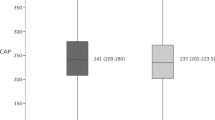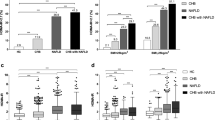Abstract
It has been shown that the hepatitis C virus (HCV) core protein reduces the activity of the microsomal triglyceride transfer protein (MTP) and could lead to steatosis in HCV-infected patients. Experimentally, apolipoprotein-AII (apoAII), which restores triglyceride secretion altered by the HCV core protein, could be protective against HCV steatosis. On the other hand, increasing plasma concentrations of mouse apoAII in transgenic mice produced several aspects of insulin-resistance syndrome, which also is implicated in the pathogenesis of HCV steatosis. This study was designed to investigate the role of apoAII in HCV-related steatosis in humans. Sixty-five hospitalized patients with chronic HCV were included in this study to assess the effects of apoAII, body mass index (BMI), age, insulin sensibility (HOMA), and leptin level on steatosis. Steatosis was observed in 55.3% of patients. Apo-AII was significantly associated with HOMA and with leptin concentrations. In univariate analyses, age, BMI, increased leptin level, increased HOMA, and increased apoAII concentration were associated with steatosis. In multivariate analysis, steatosis was associated with apoAII concentration, age, gender, and BMI. Contrary to previous hypotheses, apoAII is not a protective factor against HCV steatosis but is significantly associated with the development of liver steatosis. The fact that the plasma levels of apoAII correlate with HOMA and leptin levels in HCV-infected patients suggests that apoAII may contribute to hepatic steatosis progression in relationship to visceral obesity, insulin resistance, and metabolism of triglyceride-rich lipoproteins.
Similar content being viewed by others
References
Lonardo A, Adinolfi LE, Loria P, Carulli N, Ruggiero G, Day CP (2004) Steatosis and hepatitis C virus: mechanisms and significance for hepatic and extrahepatic disease. Gastroenterology 126:586–597
Perlemuter G, Sabile A, Letteron P, Vona G, Topilco A, Chretien Y, Koike K, Pessayre D, Chapman J, Barba G, Brechot C (2002) Hepatitis C virus core protein inhibits microsomal triglyceride transfer protein activity and very low density lipoprotein secretion: a model of viral-related steatosis. Faseb J 16:185–194
Sabile A, Perlemuter G, Bono F, Kohara K, Demaugre F, Kohara M, Matsuura Y, Miyamura T, Brechot C, Barba G (1999) Hepatitis C virus core protein binds to apolipoprotein AII and its secretion is modulated by fibrates. Hepatology 30:1064–1076
Monto A, Alonzo J, Watson JJ, Grunfeld C, Wright TL (2002) Steatosis in chronic hepatitis C: relative contributions of obesity, diabetes mellitus, and alcohol. Hepatology 36:729–736
Petit JM, Minello A, Jooste V, Bour JB, Galland F, Duvillard L, Verges B, Olsson NO, Gambert P, Hillon P (2005) Decreased plasma adiponectin concentrations are closely related to steatosis in HCV-infected patients. J Clin Endocrinol Metab 90:2240–2243
Castellani LW, Goto AM, Lusis AJ (2001) Studies with apolipoprotein A-II transgenic mice indicate a role for HDLs in adiposity and insulin resistance. Diabetes 50:643–651
van’t Hooft FM, Ruotolo G, Boquist S, de Faire U, Eggertsen G, Hamsten A (2001) Human evidence that the apolipoprotein A-II gene is implicated in visceral fat accumulation and metabolism of triglyceride-rich lipoproteins. Circulation 104:1223–1228
Kalopissis AD, Pastier D, Chambaz J (2003) Apolipoprotein A-II: beyond genetic associations with lipid disorders and insulin resistance. Curr Opin Lipidol 14:165–172
Fartoux L, Poujol-Robert A, Guechot J, Wendum D, Poupon R, Serfaty L (2005) Insulin resistance is a cause of steatosis and fibrosis progression in chronic hepatitis C. Gut 54:1003–1008
Adinolfi LE, Gambardella M, Andreana A, Tripodi MF, Utili R, Ruggiero G (2001) Steatosis accelerates the progression of liver damage of chronic hepatitis C patients and correlates with specific HCV genotype and visceral obesity. Hepatology 33:1358–136411
Giannini E, Ceppa P, Botta F, Mastracci L, Romagnoli P, Comino I, Pasini A, Risso D, Lantieri PB, Icardi G, Barreca T, Testa R (2000) Leptin has no role in determining severity of steatosis and fibrosis in patients with chronic hepatitis C. Am J Gastroenterol. 9:3211–3217
Romero-Gomez M, Castellano-Megias VM, Grande L, Irles JA, Cruz M, Nogales MC, Alcon JC, Robles A (2003) Serum leptin levels correlate with hepatic steatosis in chronic hepatitis C. Am J Gastroenterol 8:1135–1141
Julve J, Escola-Gil JC, Marzal-Casacuberta A, Ordonez-Llanos J, Gonzalez-Sastre F, Blanco-Vaca F (2000) Increased production of very-low-density lipoproteins in transgenic mice overexpressing human apolipoprotein A-II and fed with a high-fat diet. Biochim Biophys Acta 1488:233–244
Boisfer E, Lambert G, Atger V, Tran NQ, Pastier D, Benetollo C, Trottier JF, Beaucamps I, Antonucci M, Laplaud M, Griglio S, Chambaz J, Kalopissis AD (1999) Overexpression of human apolipoprotein A-II in mice induces hypertriglyceridemia due to defective very low density lipoprotein hydrolysis. J Biol Chem 274:11564–11572
Holt HB, Wild SH, Wood PJ, Zhang J, Darekar AA, Dewbury K, Poole RB, Holt RI, Phillips DI, Byrne CD (2006) Non-esterified fatty acid concentrations are independently associated with hepatic steatosis in obese subjects. Diabetologia 49:141–148
Author information
Authors and Affiliations
Corresponding author
Additional information
Supported by the Centre Hospitalier Universitaire de Dijon (PHRC 2001).
Rights and permissions
About this article
Cite this article
Petit, J.M., Jooste, V., Duvillard, L. et al. Apolipoprotein-AII Concentrations are Associated With Liver Steatosis in Patients With Chronic Hepatitis C. Dig Dis Sci 52, 3431–3434 (2007). https://doi.org/10.1007/s10620-006-9719-7
Received:
Accepted:
Published:
Issue Date:
DOI: https://doi.org/10.1007/s10620-006-9719-7




